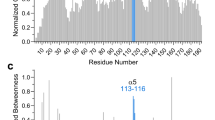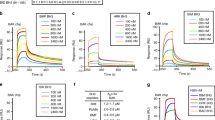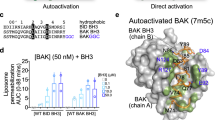Abstract
BAX is a pro-apoptotic protein of the BCL-2 family that is stationed in the cytosol until activated by a diversity of stress stimuli to induce cell death. Anti-apoptotic proteins such as BCL-2 counteract BAX-mediated cell death. Although an interaction site that confers survival functionality has been defined for anti-apoptotic proteins, an activation site has not been identified for BAX, rendering its explicit trigger mechanism unknown. We previously developed stabilized α-helix of BCL-2 domains (SAHBs) that directly initiate BAX-mediated mitochondrial apoptosis. Here we demonstrate by NMR analysis that BIM SAHB binds BAX at an interaction site that is distinct from the canonical binding groove characterized for anti-apoptotic proteins. The specificity of the human BIM-SAHB–BAX interaction is highlighted by point mutagenesis that disrupts functional activity, confirming that BAX activation is initiated at this novel structural location. Thus, we have now defined a BAX interaction site for direct activation, establishing a new target for therapeutic modulation of apoptosis.
This is a preview of subscription content, access via your institution
Access options
Subscribe to this journal
Receive 51 print issues and online access
$199.00 per year
only $3.90 per issue
Buy this article
- Purchase on Springer Link
- Instant access to full article PDF
Prices may be subject to local taxes which are calculated during checkout





Similar content being viewed by others
References
Danial, N. N. & Korsmeyer, S. J. Cell death: critical control points. Cell 116, 205–219 (2004)
Leber, B., Lin, J. & Andrews, D. W. Embedded together: the life and death consequences of interaction of the Bcl-2 family with membranes. Apoptosis 12, 897–911 (2007)
Youle, R. J. & Strasser, A. The BCL-2 protein family: opposing activities that mediate cell death. Nature Rev. Mol. Cell Biol. 9, 47–59 (2008)
Petros, A. M., Olejniczak, E. T. & Fesik, S. W. Structural biology of the Bcl-2 family of proteins. Biochim. Biophys. Acta 1644, 83–94 (2004)
Huang, D. C. & Strasser, A. BH3-only proteins—essential initiators of apoptotic cell death. Cell 103, 839–842 (2000)
Walensky, L. D. BCL-2 in the crosshairs: tipping the balance of life and death. Cell Death Differ. 13, 1339–1350 (2006)
Cheng, E. H. et al. BCL-2, BCL-X(L) sequester BH3 domain-only molecules preventing BAX- and BAK-mediated mitochondrial apoptosis. Mol. Cell 8, 705–711 (2001)
Wei, M. C. et al. Proapoptotic BAX and BAK: a requisite gateway to mitochondrial dysfunction and death. Science 292, 727–730 (2001)
Li, P. et al. Cytochrome c and dATP-dependent formation of Apaf-1/caspase-9 complex initiates an apoptotic protease cascade. Cell 91, 479–489 (1997)
Sattler, M. et al. Structure of Bcl-xL–Bak peptide complex: recognition between regulators of apoptosis. Science 275, 983–986 (1997)
Certo, M. et al. Mitochondria primed by death signals determine cellular addiction to antiapoptotic BCL-2 family members. Cancer Cell 9, 351–365 (2006)
Chen, L. et al. Differential targeting of prosurvival Bcl-2 proteins by their BH3-only ligands allows complementary apoptotic function. Mol. Cell 17, 393–403 (2005)
Kim, H. et al. Hierarchical regulation of mitochondrion-dependent apoptosis by BCL-2 subfamilies. Nature Cell Biol. 8, 1348–1358 (2006)
Oltval, Z. N., Milliman, C. L. & Korsmeyer, S. J. Bcl-2 heterodimerizes in vivo with a conserved homolog, Bax, that accelerates programmed cell death. Cell 74, 609–619 (1993)
Willis, S. N. et al. Proapoptotic Bak is sequestered by Mcl-1 and Bcl-xL, but not Bcl-2, until displaced by BH3-only proteins. Genes Dev. 19, 1294–1305 (2005)
Zhai, D., Jin, C., Huang, Z., Satterthwait, A. C. & Reed, J. C. Differential regulation of Bax and Bak by anti-apoptotic Bcl-2 family proteins Bcl-B and Mcl-1. J. Biol. Chem. 283, 9580–9586 (2008)
Oltersdorf, T. et al. An inhibitor of Bcl-2 family proteins induces regression of solid tumours. Nature 435, 677–681 (2005)
Tse, C. et al. ABT-263: a potent and orally bioavailable Bcl-2 family inhibitor. Cancer Res. 68, 3421–3428 (2008)
Willis, S. N. et al. Apoptosis initiated when BH3 ligands engage multiple Bcl-2 homologs, not Bax or Bak. Science 315, 856–859 (2007)
Annis, M. G. et al. Bax forms multispanning monomers that oligomerize to permeabilize membranes during apoptosis. EMBO J. 24, 2096–2103 (2005)
Goping, I. S. et al. Regulated targeting of BAX to mitochondria. J. Cell Biol. 143, 207–215 (1998)
Gross, A., Jockel, J., Wei, M. C. & Korsmeyer, S. J. Enforced dimerization of BAX results in its translocation, mitochondrial dysfunction and apoptosis. EMBO J. 17, 3878–3885 (1998)
Wolter, K. G. et al. Movement of Bax from the cytosol to mitochondria during apoptosis. J. Cell Biol. 139, 1281–1292 (1997)
Chipuk, J. E. et al. Direct activation of Bax by p53 mediates mitochondrial membrane permeabilization and apoptosis. Science 303, 1010–1014 (2004)
Nie, C. et al. Cysteine 62 of Bax is critical for its conformational activation and its proapoptotic activity in response to H2O2-induced apoptosis. J. Biol. Chem. 283, 15359–15369 (2008)
Pagliari, L. J. et al. The multidomain proapoptotic molecules Bax and Bak are directly activated by heat. Proc. Natl Acad. Sci. USA 102, 17975–17980 (2005)
Cartron, P. F. et al. The first α helix of Bax plays a necessary role in its ligand-induced activation by the BH3-only proteins Bid and PUMA. Mol. Cell 16, 807–818 (2004)
Harada, H., Quearry, B., Ruiz-Vela, A. & Korsmeyer, S. J. Survival factor-induced extracellular signal-regulated kinase phosphorylates BIM, inhibiting its association with BAX and proapoptotic activity. Proc. Natl Acad. Sci. USA 101, 15313–15317 (2004)
Kuwana, T. et al. BH3 domains of BH3-only proteins differentially regulate Bax-mediated mitochondrial membrane permeabilization both directly and indirectly. Mol. Cell 17, 525–535 (2005)
Kuwana, T. et al. Bid, Bax, and lipids cooperate to form supramolecular openings in the outer mitochondrial membrane. Cell 111, 331–342 (2002)
Letai, A. et al. Distinct BH3 domains either sensitize or activate mitochondrial apoptosis, serving as prototype cancer therapeutics. Cancer Cell 2, 183–192 (2002)
Marani, M., Tenev, T., Hancock, D., Downward, J. & Lemoine, N. R. Identification of novel isoforms of the BH3 domain protein Bim which directly activate Bax to trigger apoptosis. Mol. Cell. Biol. 22, 3577–3589 (2002)
Walensky, L. D. et al. A stapled BID BH3 helix directly binds and activates BAX. Mol. Cell 24, 199–210 (2006)
Wang, K., Yin, X. M., Chao, D. T., Milliman, C. L. & Korsmeyer, S. J. BID: a novel BH3 domain-only death agonist. Genes Dev. 10, 2859–2869 (1996)
Suzuki, M., Youle, R. J. & Tjandra, N. Structure of Bax: coregulation of dimer formation and intracellular localization. Cell 103, 645–654 (2000)
Battiste, J. L. & Wagner, G. Utilization of site-directed spin labeling and high-resolution heteronuclear nuclear magnetic resonance for global fold determination of large proteins with limited nuclear Overhauser effect data. Biochemistry 39, 5355–5365 (2000)
Hsu, Y. T. & Youle, R. J. Nonionic detergents induce dimerization among members of the Bcl-2 family. J. Biol. Chem. 272, 13829–13834 (1997)
Villunger, A. et al. p53- and drug-induced apoptotic responses mediated by BH3-only proteins Puma and Noxa. Science 302, 1036–1038 (2003)
Chen, D. & Zhou, Q. Caspase cleavage of BimEL triggers a positive feedback amplification of apoptotic signaling. Proc. Natl Acad. Sci. USA 101, 1235–1240 (2004)
Hsu, Y. T., Wolter, K. G. & Youle, R. J. Cytosol-to-membrane redistribution of Bax and Bcl-XL during apoptosis. Proc. Natl Acad. Sci. USA 94, 3668–3672 (1997)
Muchmore, S. W. et al. X-ray and NMR structure of human Bcl-xL, an inhibitor of programmed cell death. Nature 381, 335–341 (1996)
Cartron, P. F. et al. Involvement of the N-terminus of Bax in its intracellular localization and function. FEBS Lett. 512, 95–100 (2002)
Nechushtan, A., Smith, C. L., Hsu, Y. T. & Youle, R. J. Conformation of the Bax C-terminus regulates subcellular location and cell death. EMBO J. 18, 2330–2341 (1999)
Schinzel, A. et al. Conformational control of Bax localization and apoptotic activity by Pro168. J. Cell Biol. 164, 1021–1032 (2004)
Dlugosz, P. J. et al. Bcl-2 changes conformation to inhibit Bax oligomerization. EMBO J. 25, 2287–2296 (2006)
Bird, G. H., Bernal, F., Pitter, K. & Walensky, L. D. Synthesis and biophysical characterization of stabilized α-helices of BCL-2 domains. Methods Enzymol. 446, 369–386 (2008)
Walensky, L. D. et al. Activation of apoptosis in vivo by a hydrocarbon-stapled BH3 helix. Science 305, 1466–1470 (2004)
Pitter, K., Bernal, F., Labelle, J. & Walensky, L. D. Dissection of the BCL-2 family signaling network with stabilized α-helices of BCL-2 domains. Methods Enzymol. 446, 387–408 (2008)
Grzesiek, S. & Bax, A. The importance of not saturating water in protein NMR. Application to sensitivity enhancement and NOE measurements. J. Am. Chem. Soc. 115, 12593–12594 (1993)
DeLano, W. L. The PyMOL Molecular Graphics System. <http://www.pymol.org> (DeLano Scientific, 2002)
Acknowledgements
We thank E. Smith for editorial and graphics assistance, W. Beavers for amino acid analyses, A. Perry for technical assistance, C. Turner and A. Bielecki of the MIT/Harvard Center for Magnetic Resonance for NMR technical advice, and R. Youle for feedback on the manuscript. We acknowledge the indelible contributions of the late S. J. Korsmeyer, who inspired this work. L.D.W. is supported by National Cancer Institute (NCI) grant 5P01CA92625, a Burroughs Wellcome Fund Career Award in the Biomedical Sciences, a Culpeper Scholarship in Medical Science from the Goldman Philanthropic Partnerships, an American Society of Hematology Junior Faculty Scholar Award, and a grant from the William Lawrence Children’s Foundation. This research was also supported by NCI grant 5RO1CA50239. N.T. is supported by the Intramural Research Program of the National Heart, Lung and Blood Institute, NIH. E.H.-Y.C. is supported by the Searle Scholars Program and NCI grant 5RO1CA125562.
Author Contributions G.H.B. and L.D.W. designed, synthesized and characterized the SAHBs for structural and biological studies. M.S. and N.T. performed the NMR analysis of BAX and BIM SAHB, and E.G. and L.D.W. conducted the PRE NMR analysis of BAX using MTSL-derivatized SAHBs and performed the structure calculations. E.G., M.L.D. and K.P. executed the in vitro BAX activation studies. H.-C.T., H.K. and E.H.-Y.C. generated the BAX-reconstituted DKO MEFs and analysed their response to staurosporine, and S.G.K. examined the cellular response to BIM SAHB treatment.
Author information
Authors and Affiliations
Corresponding authors
Ethics declarations
Competing interests
L.D.W. is a scientific advisory board member and consultant for Aileron Therapeutics, Inc.
Supplementary information
Supplementary Information
This file contains Supplementary Figures S1-S10 with Legends, Supplementary Table 1, Supplementary Methods and Supplementary Notes (PDF 858 kb)
Rights and permissions
About this article
Cite this article
Gavathiotis, E., Suzuki, M., Davis, M. et al. BAX activation is initiated at a novel interaction site. Nature 455, 1076–1081 (2008). https://doi.org/10.1038/nature07396
Received:
Accepted:
Issue Date:
DOI: https://doi.org/10.1038/nature07396
This article is cited by
-
MiR-181a protects the heart against myocardial infarction by regulating mitochondrial fission via targeting programmed cell death protein 4
Scientific Reports (2024)
-
BAX activation in mouse retinal ganglion cells occurs in two temporally and mechanistically distinct steps
Molecular Neurodegeneration (2023)
-
Chemical modulation of cytosolic BAX homodimer potentiates BAX activation and apoptosis
Nature Communications (2023)
-
Mechanisms of BCL-2 family proteins in mitochondrial apoptosis
Nature Reviews Molecular Cell Biology (2023)
-
Parkin-mediated ubiquitination inhibits BAK apoptotic activity by blocking its canonical hydrophobic groove
Communications Biology (2023)
Comments
By submitting a comment you agree to abide by our Terms and Community Guidelines. If you find something abusive or that does not comply with our terms or guidelines please flag it as inappropriate.



